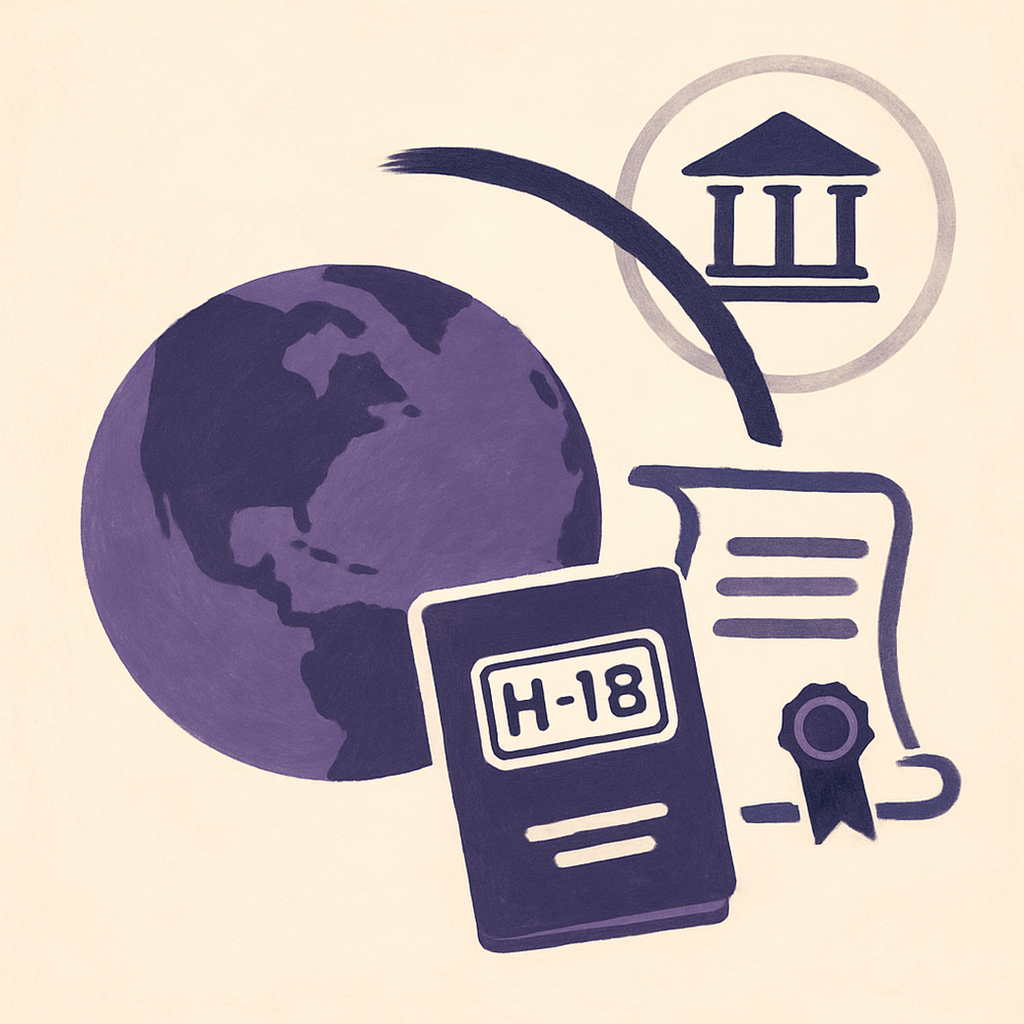When the White House issued the September 19, 2025, proclamation introducing a $100,000 fee for new H-1B filings, it sent a wave of concern through HR teams, hiring managers, and employees on work visas. The announcement was brief, the language was broad, and the implications — at least on the surface — felt staggering.
Weeks later, as more details have surfaced, HR leaders are still fielding questions from every direction: leadership wants to know whether to budget for next year’s lottery, employees on OPT are worried about their future, and recruiting teams are asking if they should even discuss sponsorship with candidates.
This article helps with HR strategy for H-1B $100K fee, so they can do what they do best — bring clarity, structure, and calm to uncertainty.
Understanding the H-1B $100K Fee
The proclamation, effective September 21, 2025, restricts entry for certain nonimmigrant workers unless the sponsoring employer pays a $100,000 fee per new H-1B petition. The rule does not apply to renewals, transfers, or employees already counted toward the H-1B cap.
However, multiple lawsuits have already been filed by industry associations and employer coalitions arguing that the President does not have the statutory authority to impose such a fee. These cases could lead to a court injunction that delays or nullifies the proclamation altogether.
Two possible outcomes HR should prepare for:
- If litigation succeeds: The $100K fee could be blocked or delayed, allowing the FY2026 H-1B lottery to proceed as normal.
- If litigation fails: Employers would face a significant new cost barrier to sponsoring new H-1B employees. Filing volumes would likely drop dramatically, potentially reshaping the U.S. talent market.
HR strategy H-1B $100K fee: What HR Should Do Right Now
Even without final clarity, HR can take measured steps to guide leadership, employees, and recruiters. The goal isn’t to predict the outcome — it’s to be ready for both.
1. Guiding Company Leadership
Executives will want a yes-or-no answer: Should we plan to file next year or not?HR’s job is to keep the discussion fact-based, strategic, and adaptable.
Action Steps:
- Create a list of affected employees: Identify all current or potential H-1B candidates (e.g., OPT, STEM OPT, or F-1 workers). Coordinate with their hiring managers to evaluate each situation.
- Quantify impact in workforce terms: Instead of cost models, focus on talent impact — which roles, teams, or projects rely on these employees.
- Highlight strategic risk: Freezing sponsorship could signal instability to existing employees and potential hires.
- Engage legal counsel early: Ask your immigration counsel to provide regular briefings for HR and leadership, summarizing litigation progress.
- Develop a contingency plan: If the fee goes into effect, prepare guidance on which roles or departments could still justify sponsorship based on business-critical needs.
Leadership Briefing Example:
“Here’s our current assessment: the proclamation applies only to new H-1Bs. Renewals and transfers remain unaffected. Litigation is ongoing and could suspend the rule. We recommend pausing major decisions until there’s legal clarity, while identifying affected employees and maintaining readiness to support them.”
2. Calming Employees on OPT or STEM OPT
Many employees on OPT or STEM OPT status are the most anxious right now. They’re already in the U.S., contributing to your business, and hoping for a long-term future. HR must combine transparency with reassurance.
What to Communicate:
- Reassure them: Their current work authorization (OPT/STEM OPT EAD) remains valid. Nothing changes about their employment eligibility.
- Acknowledge the uncertainty: “We know there’s anxiety, and we’re watching the legal challenges closely.” Avoid speculation about final outcomes.
- Commit to updates: Promise to share new information as soon as the courts or USCIS issue clarifications.
- Work with counsel to create tailored plans: Collaborate with your immigration partner to assess each employee’s case individually — taking into account their visa status, expiration date, education level, and country of birth.
- Highlight company commitment: Reinforce that the company values their work and will explore all viable pathways to retain them — including O-1, TN, or L-1 visas if H-1B sponsorship becomes impractical.
Internal Communication Template:
“We understand the uncertainty this has caused. The new H-1B fee proposal is under active legal challenge, and we’re monitoring developments closely. Your current authorization remains valid. Our immigration partners are evaluating each employee’s case individually, and we’ll communicate promptly if anything changes.”
Additional HR Recommendations:
- Host Q&A sessions: Give employees space to ask questions directly to HR or your immigration counsel.
- Train managers: Equip people managers with consistent talking points to prevent mixed messages.
Employee FAQ for HR to Distribute:
- Does this change my current OPT or STEM OPT status? (No.)
- Will this affect my ability to work next year? (Not immediately; your EAD validity governs that.)
- What happens if my H-1B lottery isn’t filed next year? (The company and counsel will review other visa options.)
- Will I have to leave the U.S.? (No, as long as you maintain valid status.)
- Who can I contact with questions? (Provide HR and counsel contact info.)
3. Guiding the Recruiting Team
Recruiters are on the front lines, and inconsistent communication can quickly damage candidate trust. HR should help them lead with facts and confidence.
Action Steps:
- Provide approved talking points:
- “Transfers and existing H-1B employees aren’t affected.”
- “The $100K fee applies only to new cap-subject filings, which are still under legal review.”
- “We continue to evaluate all available visa options.”
- Train recruiters on alternatives: Host a short session on TN, O-1, E-3, and L-1 categories so they know when to flag candidates for review.
- Reinforce company stability: Emphasize the organization’s long-term commitment to sponsored employees — this builds confidence and strengthens your employer brand.
- Align with hiring managers: Ensure job offers and compensation discussions reflect realistic timelines and sponsorship strategies.
Quick Reference Guide for Recruiters (HR to Share):
Visa TypeWho QualifiesRecruiter ActionO-1Exceptional engineers, researchers, or designers with significant accomplishmentsFlag for HR/immigration review.TN (Canada)Canadian citizens in eligible professionsConfirm citizenship; escalate to HR for TN eligibility review.TN (Mexico)Mexican citizens in eligible professionsCandidate must apply at consulate; coordinate with HR.E-3 / H-1B1Citizens of Australia, Singapore, or ChileEscalate to HR to explore eligibility.L-1Current employees of the company’s foreign affiliateCheck internal transfer eligibility and tenure requirements.
Example Recruiter Message:
“We’re aware of the proposed $100K filing fee, but it’s not final. The rule is being challenged in court, and existing H-1B transfers or renewals are unaffected. Our company will continue supporting eligible candidates and exploring the best immigration pathway available.”
Pro Tip for HR: Create a one-page “Visa Strategy Snapshot” that lists visa types, qualifications, and recruiter steps to escalate potential cases to HR or legal.
If the $100K Fee Takes Effect
If the courts uphold the proclamation, employers may need to rethink their H-1B strategy for the FY2026 lottery.
Expectations:
- H-1B filings will likely plummet, increasing competition for alternative visa categories.
- Companies with higher-paying roles (Level III/IV) may continue to sponsor selectively.
- Startups and smaller firms could be disproportionately affected by the cost.
HR Response Plan:
- Prioritize internal talent: Focus on employees already in the U.S. with valid work authorization.
- Diversify visa use: Explore other routes — O-1 for high-achievers, TN for Canadians/Mexicans, L-1 for internal transfers.
- Develop a global hiring strategy: If U.S. sponsorship becomes cost-prohibitive, collaborate with leadership on nearshore or remote hiring alternatives.
If the $100K Fee Is Blocked
If litigation succeeds, HR should help leadership re-engage with normal H-1B planning quickly.
Next Steps:
- Restart lottery prep: Resume identifying eligible employees and candidates early to ensure readiness.
- Communicate stability: Let current visa holders know their long-term prospects remain intact.
- Rebuild candidate confidence: Encourage recruiters to proactively share the update with candidates who paused applications due to uncertainty.
- Review lessons learned: Document what worked in your communication process and where HR can improve responsiveness for future policy shifts.
Key Takeaway for HR Leaders
The proclamation created confusion, but it also underscored HR’s strategic role. HR isn’t just a compliance function — it’s the steady voice between legal complexity and operational clarity.
Your next steps should focus on:
- Keeping leadership grounded in facts, not fear.
- Keeping employees informed, not anxious.
- Keeping recruiting teams aligned and proactive.
Whether the fee holds or falls, HR’s calm, transparent communication will determine how the company — and its people — weather the uncertainty ahead.


.svg)


